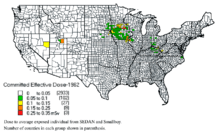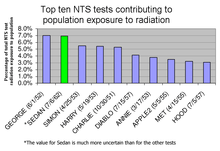Sedan (nuclear test)
| Storax Sedan | |
|---|---|
 Storax Sedan explosion. | |
| Information | |
| Country | United States |
| Test series |
Operation Storax Operation Plowshare |
| Test site | Nevada Test Site |
| Date | July 6, 1962 |
| Test type | Underground |
| Yield | 104 kt |
Storax Sedan was a shallow underground nuclear test conducted in Area 10 of Yucca Flat at the Nevada National Security Site on 6 July 1962 as part of Operation Plowshare, a program to investigate the use of nuclear weapons for mining, cratering, and other civilian purposes.[1] The radioactive fallout from the test contaminated more US residents than any other nuclear test. The Sedan Crater is the largest man-made crater in the United States, and is listed on the National Register of Historic Places.
Effects

Sedan was a thermonuclear device with a fission yield less than 30% and a fusion yield about 70%.[2][3] According to Carey Sublette, the design of the Sedan device was similar to that used in Shot Bluestone and Swanee of operation Dominic conducted days and months prior to Sedan respectively, and was therefore not unlike the W56 high yield Minuteman I missile warhead.[4] The device had a diameter of 43 cm (17 in), length of 96.5 cm (38.0 in), and a weight of 212.2 kg (468 lb).[4]
The timing of the test put it within the Operation Storax fiscal year, but Sedan was functionally part of Operation Plowshare, and the test protocol was sponsored and conducted by Lawrence Livermore National Laboratory with minimal involvement by the United States Department of Defense. The explosive device was lowered into a shaft drilled into the desert alluvium 194 m (636 ft) deep.[3] The fusion-fission blast had a yield equivalent to 104 kilotons of TNT (435 terajoules) and lifted a dome of earth 90 m (300 ft) above the desert floor before it vented at three seconds after detonation, exploding upward and outward displacing more than 11,000,000 t (11,000,000 long tons; 12,000,000 short tons) of soil.[5] The resulting crater is 100 m (330 ft) deep with a diameter of about 390 m (1,280 ft). A circular area of the desert floor five miles across was obscured by fast-expanding dust clouds moving out horizontally from the base surge, akin to pyroclastic surge.[6] The blast caused seismic waves equivalent to an earthquake of 4.75 on the Richter scale.[1] The radiation level on the crater lip at 1 hour after burst was 500 R per hour (130 mC/(kg·h)),[7] but it dropped to 500 mR per hour after 27 days.[7]
Within 7 months (~210 days) of the excavation, the bottom of the crater could be safely walked upon with no protective clothing,[8] with radiation levels at 35 mR per hour after 167 days.[7]
Fallout


The Sedan shot resulted in a radioactive cloud that separated into two plumes, rising to 3.0 km and 4.9 km (10,000 ft and 16,000 ft). The two plumes headed northeast and then east in roughly parallel paths towards the Atlantic Ocean.[9] Nuclear fallout was dropped along the way, narrowly dispersed in a relatively small number of United States counties.[3] Detected radioactivity was especially high in eight counties in Iowa and one county each in Nebraska, South Dakota and Illinois. Most heavily affected counties were Howard, Mitchell and Worth counties in Iowa, as well as Washabaugh County in South Dakota, an area that has since been incorporated into Jackson County and is wholly within Pine Ridge Indian Reservation. These four counties measured maximum levels higher than 6,000 microcuries per square meter (220 MBq/m2).[10]
Of all the nuclear tests conducted in the USA, Sedan ranked highest in overall activity of radionuclides in fallout. The test released 880,000 curies (33 PBq) of radioactive iodine-131, an agent of thyroid disease, into the atmosphere.[11] Sedan ranked first in percentages of these particular radionuclides detected in fallout: 198Au, 199Au, 7Be, 99Mo, 147Nd, 203Pb, 181W, 185W and 188W. Sedan ranked second in these radionuclides in fallout: 57Co, 60Co and 54Mn. Sedan ranked third in the detected amount of 24Na in fallout. In countrywide deposition of radionuclides, Sedan was highest in the amount of 7Be, 54Mn, 106Ru and 242Cm, and second highest in the amount of deposited 127mTe.[10] Although not detected in fallout, in part because the explosion was well contained, gold (Au) was used in the W71 warhead, with one 1971 test conducted in the Amchitka islands off Alaska.
Sedan's fallout contamination contributed a little under 7% to the total amount of radiation which fell on the U.S. population during all of the nuclear tests at NTS. Sedan's effects were similar to shot "George" of Operation Tumbler-Snapper, detonated on June 1, 1952, which also contributed about 7% to the total radioactive fallout. Uncertainty regarding exact amounts of exposure prevents knowing which of the two nuclear tests caused the most; George is listed as being the highest exposure and Sedan second highest by the United States Department of Health and Human Services, Centers for Disease Control and Prevention, and the National Cancer Institute.[12][13]
If this test was conducted in 1965+, when improvements in device design were realized, a "100-fold" reduction in radiation release was considered feasible.[14]
Conclusions
The Plowshare project developed the Sedan test in order to determine the feasibility of using nuclear detonations to quickly and economically excavate large amounts of earth and rock. Proposed applications included the creation of harbors, canals, open pit mines, railroad and highway cuts through mountainous terrain and the construction of dams. Assessment of the full effects of the Sedan shot showed that the radioactive fallout from such uses would be extensive. Public concerns about the health effects and a lack of political support eventually led to abandonment of the concept.[15] No such nuclear excavation has since been undertaken by the US,[16] though the Soviet Union continued to pursue the concept through their program Nuclear Explosions for the National Economy, particularly with their 140 kiloton Chagan (nuclear test), which created an artificial lake reservoir (see Lake Chagan).
Diplomatic issue with "Sudan"
On March 2, 2005 Ellen Tauscher, a Californian Democratic member of the U.S. House of Representatives, used Sedan as an example of a test which produced a considerable amount of radioactive fallout while giving congressional testimony on the containment of debris from nuclear testing. However the word Sedan was incorrectly transcribed as the country Sudan in the Congressional Record.
Within days of the error, the international community took notice. Sudanese officials responded by stating that "the Sudanese government takes this issue seriously and with extreme importance". The Chinese Xinhua General News Service even published an article claiming that the Sudanese government blamed the U.S. for raising cancer rates among the Sudanese people.[17] Despite the U.S. embassy in Khartoum issuing a statement clarifying that it was a typographic error, Mustafa Osman Ismail, the Sudanese Foreign Minister, stated his government would continue investigating the claims.[18]
See also
References
- 1 2 "NTS 50th Anniversary Newsletter—Sedan Tested Use of Nuclear Explosives to Move Earth". US Department of Energy Nevada Site Office. Retrieved 25 September 2011.
- ↑ Information sign at the crater:
- 1 2 3 United States Nuclear Tests; July 1945 through September 1992, DOE/NV--209-REV 15 December 2000, p. xv.
- 1 2 Operation Storax, Sun Beam, and Roller Coaster 1962-1963: Nevada Test Site, Nellis Air Force Range (Nevada) Last changed 20 September 1997
- ↑ "Operation Storax, Sun Beam, and Roller Coaster". Nuclear Weapons Archive. 20 September 1997. Retrieved 2008-07-14.
- ↑ Nevada Test Site Office. Library. Films. Historical Test Films
- 1 2 3 Information sign at the crater:
- ↑ "Possibilities for peaceful nuclear explosions. An IAEA review of the 1968 book: The constructive uses of nuclear explosions by Edward Teller." (PDF).
- ↑ The Utah Democratic Progressive Caucus. Press Releases. Nuclear Testing Packet
- 1 2 Miller, Richard L. (2002). U.S. Atlas of Nuclear Fallout, 1951-1970. 1 (Abridged General Reader ed.). Two Sixty Press. p. 340. ISBN 1-881043-13-4. Retrieved 2008-07-19.
- ↑ National Cancer Institute. National Institute of Health. History of the Nevada Test Site and Nuclear Testing Background
- ↑ Report on the Feasibility of a Study of the Health Consequences to the American Population from Nuclear Weapons Tests Conducted by the United States and Other Nations, Vol 1. Technical Report. Department of Health and Human Services, Centers for Disease Control and Prevention, and the National Cancer Institute. May 2005
- ↑ Top Ten Contributors to Population Exposure Figure 17. Appendix to Report on the Feasibility of a Study of the Health Consequences to the American Population from Nuclear Weapons Tests Conducted by the United States and Other Nations, Vol 1. Technical Report. Department of Health and Human Services, Centers for Disease Control and Prevention, and the National Cancer Institute. May 2005
- ↑ Declassified U.S. Nuclear Test Film #35 c. 29:30 minutes
- ↑ Center for Digital Discourse and Culture, Virginia Tech. U.S. Nuclear Testing from Project Trinity to the Plowshare Program Abby A. Johnson. (1986)
- ↑ Nevada Test Site Office. Library. Factsheets. Plowshare Program
- ↑ "Roundup of 2005 news articles and congressional testimony related to the Sedan/Sudan mixup". Federation of American Scientists. March 2005. Retrieved 2008-07-14.
- ↑ "Typing error causes nuclear scare". BBC. 11 March 2005. Retrieved 2008-07-14.
External links
| Wikimedia Commons has media related to Sedan (nuclear test). |
- US government movie about the Sedan test
- Sedan Underground Nuclear Test video
- Virtual-Reality tour of Sedan Site
- Sedan Crater at the Online Nevada Encyclopedia
Coordinates: 37°10′37″N 116°2′46″W / 37.17694°N 116.04611°W